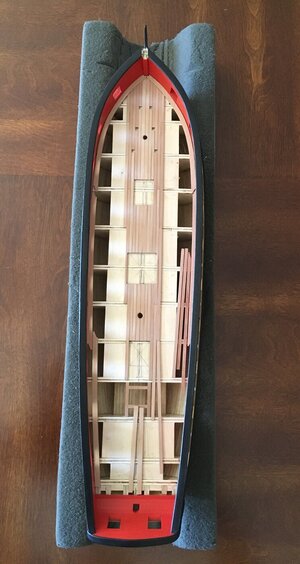
A small progress update
The pear deck planking is underway. I know cutting the pear with the margins glued down will be difficult. So the margin planks are staying loose until I have completed the joggling. Obviously nothing is sanded or scraped yet.
I previously cut planking strips 1/8” x 1/16” from stock billets in line with the kit sizes. I tried out various arrangements of planking but wanted to keep to the four-butt system the kit designer suggests. I also, as discussed previously, was interested in trying to maintain symmetry of the planks across the deck. The manual suggests keeping the average length of planks to cover four bulkheads.
I decided I wanted the plank ends to butt against the hatch framing (coamings) and larger structures where possible instead of placing those items on the decking after it is laid. Instead of fiddling with tiny pieces of planking I am going to place the smaller structures onto the planks but lay decking around the larger ones. In addition I tried to minimize the cut-outs of the planks around the future companionway, coamings and hatches. To do this I will have to adjust the width of the future structures but only minimally. I also increased the width of the two off-centre line planks by 1/32”. That gives me a clean line each side of the for’d and aft structures but not for the one amidships. So far so good, possibly, maybe, I hope so

Once the planks are laid the manual cautions to ensure there is enough space between the deck and the underside of the carronade sled supports. No problem, I had measured and planned for that some while back. However, as I laid the planks I realized a false deck would have helped enormously. To have done that would have decreased the deck to bottom carronade height, which meant thinner deck planks but they were already cut. So that was not going to happen but it will be planned for in a future build. Lesson learned.
Each plank is blackened using a 2B pencil but on one side only and the butt end. I made sure to blacken the whole side depth of the plank so when I sand and scrape them the dark “caulking” will still show. Mind you at this stage I don’t really see that effect, yet. I might be laying them too close but applying the deck finish on completion may show it a lot better. In the future I think I’ll use very thin temporary spacers as I lay the planks so the caulked gaps have a more consistent look.
Thanks for taking the time to read another of my somewhat wordy posts. The support I get from you all is much appreciated.







